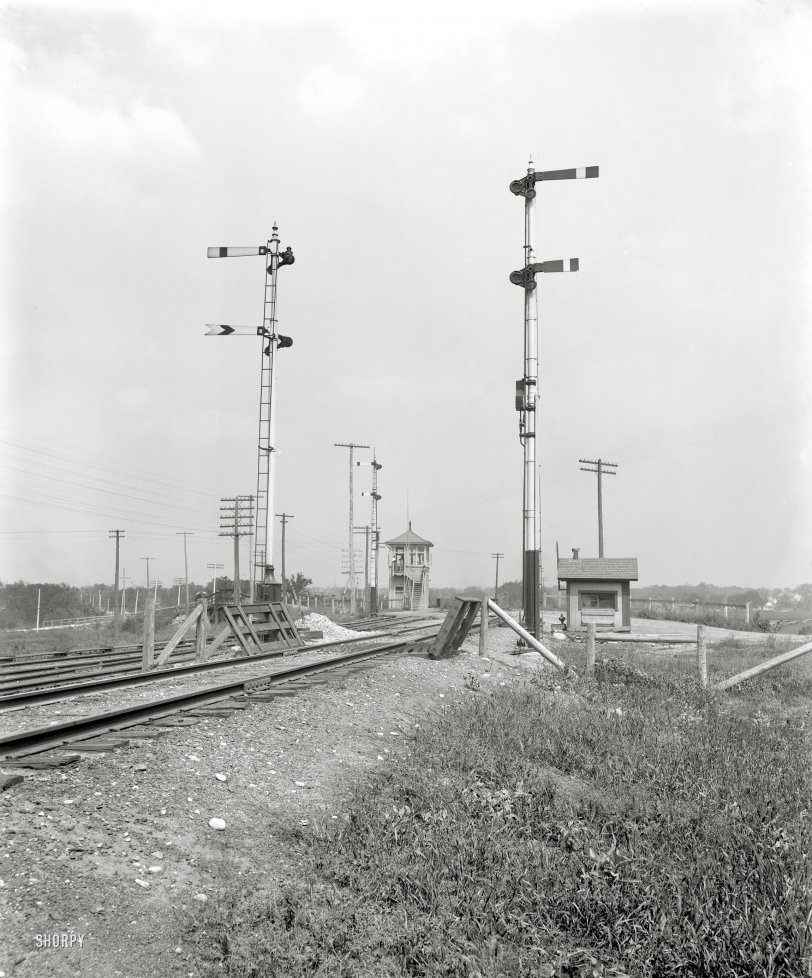


Framed or unframed, desk size to sofa size, printed by us in Arizona and Alabama since 2007. Explore now.
Shorpy is funded by you. Patreon contributors get an ad-free experience.
Learn more.

- Tough Guys
- Lost in Toyland
- And without gloves
- If I were a blindfolded time traveler
- Smoke Consumer Also Cooks
- Oh that stove!
- Possibly still there?
- What?!?
- $100 Reward
- Freeze Frame
- Texas Flyer wanted
- Just a Year Too Soon
- WWII -- Replacing men with women at the railroad crossing.
- Yes, Icing
- You kids drive me nuts!
- NOT An Easy Job
- I wonder
- Just add window boxes
- Icing Platform?
- Indiana Harbor Belt abides
- Freezing haze
- Corrections (for those who care)
- C&NW at Nelson
- Fallen Flags
- A dangerous job made worse
- Water Stop
- Passenger trains have right of way over freights?
- Coal
- Never ceases to amaze me.
- Still chuggin' (in model form)
Print Emporium
The Sentinels: 1900

Circa 1900. "Interlocking signal plant, Chicago & Alton Railway." 8x10 inch dry plate glass negative, Detroit Publishing Company. View full size.
Not electric
I do not believe these signals are electrically lit. Most likely kerosene, which is why they are equipped with ladders. They are also not in any way electrically assisted. Look at the large number of horizontal pipes which emerge from in front of the tower and run along the ground, most easily seen first at the left edge of the photo when in original view. Those are control rods, moved by men (STRONG men!!) using levers inside the tower, and they are connected to switches, signals and derails which control where the trains go. You can see the control rods at the bottom of the right hand signal. The vertical direction of the movement is accomplished by using a bell crank, and you can see the disk-shaped counterweights which lessen the effort needed to move the semaphore's blades at the base of the signal mast.
I think that the trackwork which this tower controls is principally behind the photographer, based on the large number (about a dozen) of control rods heading back behind the viewer. I also think that there is another track, diagonal to the ones we see here, running along a line defined by the telephone poles to the left, which runs under the wooden bridge which appears behind the left of the two cattle guards, and would evidently run under the C&A lines we see.
I am also curious (and will be forever if another photo doesn't someday reveal the answer) why the nearest track is separated from the others by the wire fencing and the cattle guard. Are we standing ia cattle pen area where cattle are off-loaded, fed, watered and rested before being reloaded and shipped further on, as was required by law?
Railroad Semaphores
I have known for a long time that these semaphores were used to control traffic on railway lines but I didn't know how it was done or what information was passed to the engineer of a locomotive. There is a very in-depth description of different railway signalling apparatus at this site (www.railroadsignals.us). From their description I would think that both of these semaphores are signalling for the train to stop.
In case you were wondering
In railway signalling, an interlocking is an arrangement of signal apparatus that prevents conflicting movements through an arrangement of tracks such as junctions or crossings. The signalling appliances and tracks are sometimes collectively referred to as an interlocking plant. An interlocking is designed so that it is impossible to give clear signals to trains unless the route to be used is proved to be safe.
No tie plates etc
Interesting view--the rails are spiked directly to the rotting ties---no tie plates. Nevertheless, unlike the main on many of today's railroads, the spikes are not partly pulled out by the up and down motion of the trains passing. Perhaps frequent track walkers with sledges keep a watchful eye. The semaphore signals are likely mechanically controlled from the tower---and the light indicators are kerosene fired. There is wiring to the gear box on the signal stand to the right---electric assist? I do not see another railroad crossing and no signals controlling that line which would also be controlled from the tower. So what does the tower control? Perhaps two Alton lines merging somewhere up forward and from the left of the tower.
Cattle Guards?
What are those cattle guard lookin' things -- any ideas?
[They're cattle guards. - Dave]
























On Shorpy:
Today’s Top 5